- S.D. Eibar ready for maiden La Liga outing
- SD Eibar stengthen ahead of debut La Liga season
- Can ‘Super Mario’ live up to expectations in Madrid?
- MAN IN THE GROUND – Brentford 0 – 4 Osasuna
- Historic Basque derby welcomes S.D. Eibar to La Liga
- Munich to Madrid, via Brazil – Tony Kroos
- Rakitic in Spanish Switch
- Can Spain find redemption in Rio?
- Viva Espana! A season of redemption for Spanish football
- From the old to the new: who can fill the void in years to come for La Roja?
Estadio La Rosaleda- Home of Málaga CF
- Updated: 30 December, 2011
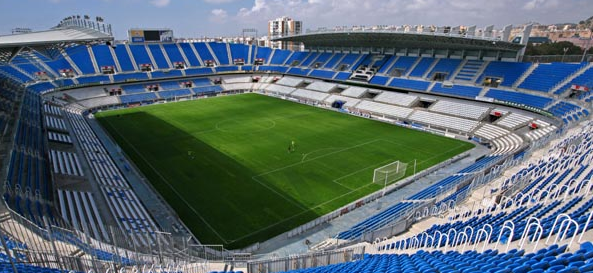
Charting the history of some Spanish clubs can be more complicated than following the most convoluted private affairs of a Hollywood star.
Step forward the city of Málaga, who over the past century has seen its club’s experience mergers, take-overs, economic ruin and in the past past year, financial salvation.
To start with, we have to go back to 1904 and the formation of Málaga Foot-Ball Club. This was a fairly low key arrangement of inter-club matches interspersed with periods of inactivity. In 1912 Football Club Malagueno was formed by students of the Colegio de El Palo and three years later, some disgruntled members left and re-energised the ailing Málaga FC. In August 1922, Málaga’s first purpose built stadium, the Campo de los Baños del Carmen opened its doors and numerous local clubs, including Málaga FC used its facilities.
FC Malagueno however, opened its own enclosure the Campo del Palo, in November 1923. In 1927, Málaga FC sought and received royal patronage and became Real Malaga FC, but with increasing debts Real Málaga FC merged with another local club, Sporting Club FC, to form Málaga Sport Club. Málaga SC set up home at the Campo de Segalerva, just across the Rio Guadalmedina from a field of roses, but more of that later. FC Malagueno & Málaga SC performed well in the early years of the Tercera, with Malagueno winning the title in 1932-33.
However, at the end of that season, it became apparent to both clubs that the interests of football in Málaga would be better served if the two strongest teams became one.
On 12 April 1933 Club Deportivo Malacitano was formed and once its place in the following seasons Tercera had been confirmed, took up residency at the Campo de los Baños del Carmen. Despite finishing third in its first full season, the club was invited to compete in an expanded and regionalised second division.
Over the next four seasons, CD Malacitano finished in fifth place on three occasions and third once, before the Civil War brought a halt to the fun. They earned another third place when football
resumed for the 1939-40 season and played its final season at the Campo de los Baños del Carmen in 1940-41, finishing fifth. The final match was on 30 March 1941, when Jerez was beaten 3-1 in the Copa.
Back in 1935, the club had purchased that field of roses on the banks of the Rio Guadalmedina and set about building a larger stadium. Architects Enrique Molina and Fernando Guerrero Atencia Strachan had a budget of 500,000 pesetas and planned a 16,000 capacity stadium, but work was suspended when war broke out. Work commenced after the war, but costs had escalated and the project was scaled back. La Rosaleda, or The Rose Garden saw its first match on 13 April 1941 when A.D. Ferroviaria de Madrid was defeated 6-0.
This was earlier than planned as earlier that week the Campo de los Baños del Carmen suffered flood damage. It’s official inauguration took place on 14 September 1941 when Sevilla was beaten 3-2. It was also the first match that saw the club play under the name of Club Deportivo Málaga and their now familiar blue and white striped shirts. La Rosaleda was a basic square ground with four open terraces holding 8,000.
Despite a fifth place finish in 1942-43, CD Málaga found themselves heading towards the Tercera as La Segunda was restructured. It took three years to get back to the second division, but the club marked their return with an extension to the stadium. An anfiteatro or upper tier holding 4,000 spectators was added to the west side and was opened in August 1947. A year later, looking to add depth to the team, CD Málaga acquired the place in the Tercera of local side CD San Tomás and set up a reserve team, Club Atlético Malagueño.
For the first few seasons, this second stream team played at the Campo de Segalerva, the former home of Málaga SC. The Campo de Segalerva was a fantastic little inner city stadium, tightly packed between houses and shops with just enough space for small end terraces. The dirt pitch ran right up to the walls of the neighbouring businesses and whilst Club Atlético Malagueño moved to La Rosaleda in 1950, it continued to be used by junior teams until May 2010.
With money tight, CD Malaga agreed a deal with the
municipality in 1954 to sale La Rosaleda, but remain tenants for a peppercorn rent. The first floodlights at La Rosaleda were switched on in April 1961 for a match against Real Betis and in May 1962, CD Málaga finished second in the southern section of La Segunda, before beating Racing Santander 3-1 on aggregate the play-offs to win a place back in the top flight.
The remainder of the decade saw CD Málaga reinforce their reputation as an elevador side, too good for La Segunda, but not good enough for La Primera. In spite of this uncertainty, the crowds still flocked to La Rosaleda and in 1965 the
municipality funded the extension of the east side. This was also an anfiteatro, but terraced. This along with other improvements raised the capacity to 22,000. The Spanish National side paid a visit to La Rosaleda in February 1973 and beat Greece 1-0. Their six subsequent visits to Málaga have brought a mixed bag of results, with 3 wins and 3 defeats.
The next major development at La Rosaleda was in preparation for the 1982 World Cup. From a footballing angle, Málaga was not an obvious choice, having never come close to winning a national title and La Rosaleda’s 22,000 capacity was clearly on the small side. Málaga however, was at the heart of the Costa del Sol and the stadium aside, it had all the necessary infrastructure. So what of the stadium? Well, in February 1980 the municipality signed off the budget for the expansion of the stadium.
The first phase began in the summer of 1980 and focused on the building of two new double decked end stands or fondos. The two side stands were also refurbished and seats added to both upper tiers. During the summer of 1981, the pitch was lowered and work started on adding a moat around the pitch. By December of 1981, La Rosaleda had four double deck stands, new floodlights, new pitch, a moat and four gaping holes in each corner of the stadium.
The work to “link” the stands was completed a mere
five weeks before Scotland, USSR & New Zealand began their World Cup campaigns… and not a FIFA inspection team in sight! I’ve used the word link with caution, because with the exception of the work at El Molinon in Gijon, these four corner stands were quite the worse attempt at connecting stands that I’ve seen. It’s as if each side stand had been given a set of shoulder pads. Not that CD Málaga was bothered. They now played in a stadium with a 42,000 capacity and did not have to fork out a single céntimos, which is just as well as they were up to their neck in debt.
Just prior to the start of the World Cup, CD Málaga won promotion to La Primera and their three year stay saw a ninth place finish in 1983-84. Relegation followed a year later, but the club had a last foray in the top division in seasons 1988-90. The following season saw the club miss out on an immediate return when it lost on penalties to Cadiz CF in the promotion play-offs.
By now the club’s creditors were getting impatient and with a drastically scaled back operation, CD Málaga struggled throughout the 1991-92 season. The players went unpaid for long periods and eventually the club finished eighteenth. With debts of over 200 million pesetas, the club’s directors took the decision to register the reserve team, Club Atlético Malagueño as a separate entity, thus ensuring that football could continue in Málaga should the first team fold. The inevitable end came on 1 July 1992, when the club was declared bankrupt. So in effect, the reserve team took on the mantle of CD Malaga and did a decent job winning the Tercera and promotion in its first full season as an independent club.
It was a step too soon however, as the club dropped out of Segunda 2b the following season. The summer of 1994 saw new owners and a new name, as on 30 June Club Atlético Malagueño became Málaga Club de Fútbol. Gradually, Málaga CF improved and the exception of a two season blip in the middle of this decade, has spent 11 of the past 13 seasons in the top division. The turn of the century saw the local municipality start a programme of redevelopment La Rosaleda that would take six years complete.
The project was designed in a joint venture by architects José Seguí and the U.T.E. Sando-Vera company and saw the complete rebuilding of the stadium, stand by stand. First to go was the old north end which was replaced with an open two tiered all-seated stand which peaked in height at the centre before sweeping down and around new corner units.
In 2002 an identical stand was erected at the southern end of ground. The first of the main stands was built in 2004 on the east side that backs on to the Rio Guadalmedina. This is slightly lower than the end stands, but unlike its
predecessor, joins up seamlessly. This double deck stand features a steel roof suspended by cables that are tethered to a series of concrete piles driven into the ground behind the stand. Finally, in 2006 the west side was replaced with a stand that matched the east side.
The result was a beautifully simple and bright stadium that undulates to its uppermost points, offering spectators a fantastic view from all of its 28,963 seats. A club museum opened at La Rosaleda in 2009 and a new pitch was laid a year later along with general improvements being made to the stadiums access points and sound system.
2010 also saw the arrival of Sheikh Abdullah Al Thani who purchased the club for a reported sum of 36 million euros. After a poor start to the season, Sheikh Al Thani brought in experienced coach Manuel Pellegrini and thanks to some big spending in the January transfer window and a run of five consecutive wins, a record for the club in the top flight, Málaga CF earned an eleventh place finish.
Sheikh Al Thani has also talked of developing a new 65,000 seat stadium after purchasing land elsewhere in Málaga. After decades of thorns and extensive pruning, it would appear that La Rosaleda is experiencing a final bloom.
_____________________________
To read more on the footballing stadiums of Spain, visit Chris’s excellent site Estadios de fútbol en España

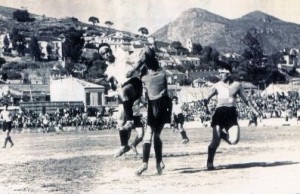
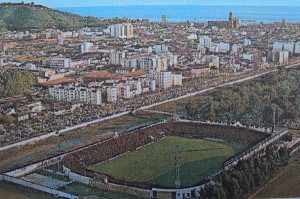
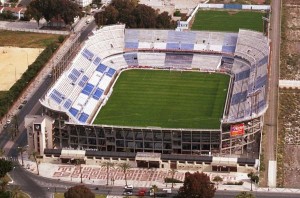
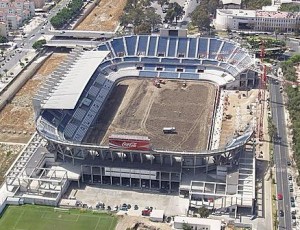
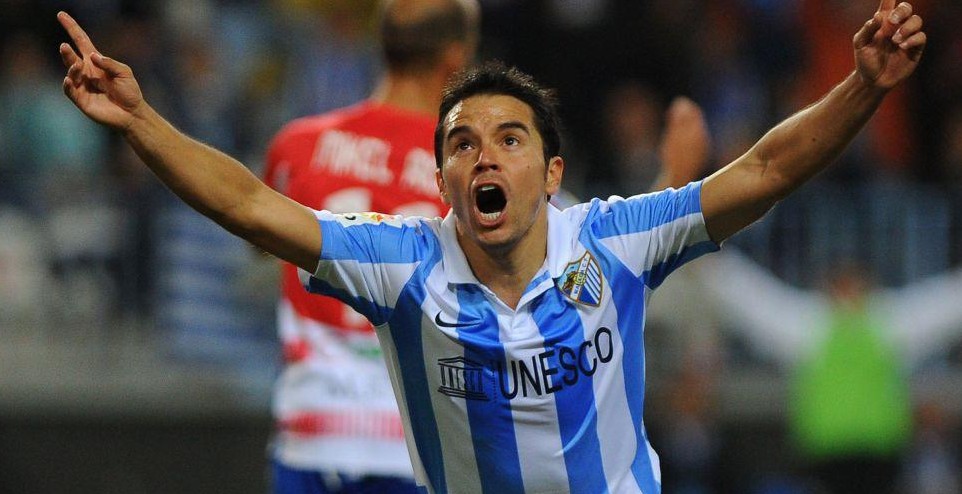
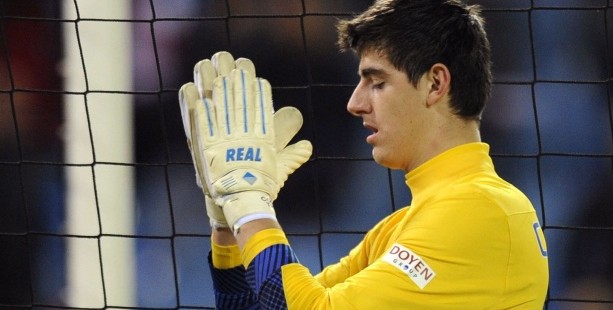
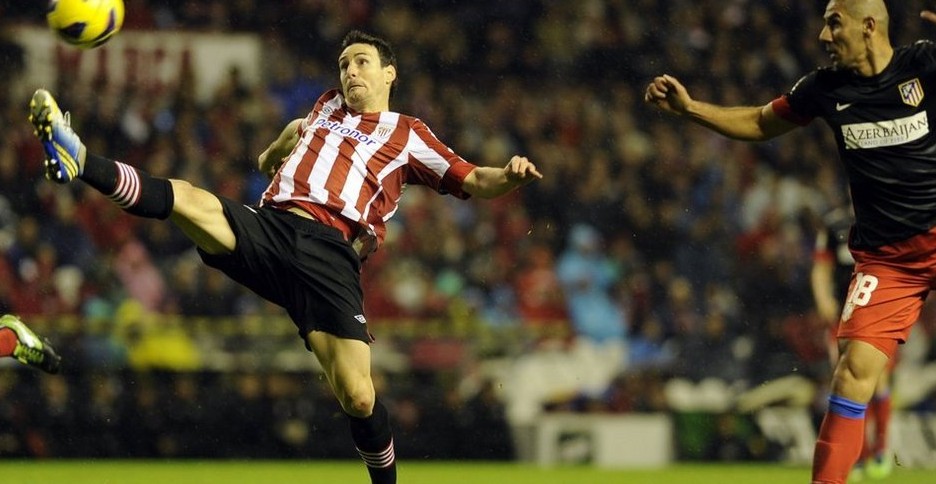


2 Comments
You must be logged in to post a comment Login